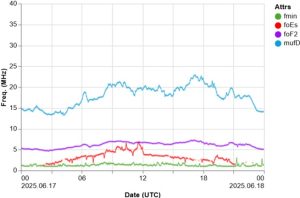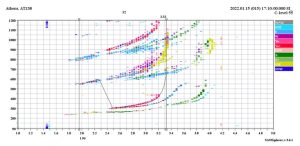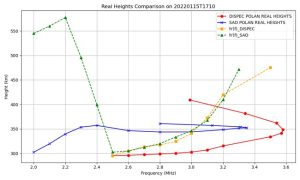The Dispec Project integrates science, AI, and open data for operational resilience and scientific excellence.
The ionosphere, an ionized component of the upper atmosphere extending from 90-1000 km of the Earth, plays an important role in modern infrastructure. It affects everything from aviation and navigation to wireless communications and emergency services.
The Dispec Project is working towards an understanding of how to monitor and understand this important part of our atmosphere. This is important as improved forecasting and long-term surveillance leads to more resilient communication, improved GPS accuracy, and stronger preparation for space weather disruptions.
Working with doctoral students and early scientists, Dispec researchers combine satellite and terrestrial data with cutting-edge data processing and artificial intelligence to provide more accurate and reliable insight into ionosphere conditions.
Scientific development under Dispec relies on accurate and timely spatial environmental data collected by networks of ground-based and space-borne platforms. These platforms send real-time data to space weather forecasting systems to support operations such as radar functions, satellite control, direction discovery, and precision navigation and positioning.
Why data accuracy is important
Given the operational importance of these systems, the accuracy and reliability of the data used to characterize spaces near the earth is extremely important. However, the following may impair data integrity:
Misinterpretation or defective post-processing caused by equipment problems (e.g. calibration errors, hardware degradation), environmental impacts (e.g., geomagnetic and tropospheric storms), misunderstandings or irregularities in the ionosphere
The digisonde station is an ionosphere sounder that collects valuable ionosphere data, not only thanks to the global coverage of the network’s global ionosphere radio observatory (GIRO), but also regularly provides analytical information on the formation of electron layers from peak electron density heights of 90 km.


Data quality issues can lead to a set of important ionosphere properties, including outliers and gaps (Figure 1), making them unsuitable for scientific and operational use.
Each data point in Figure 1 is extracted by analysis of the ionogram. Errors in interpreting raw ionogram images can lead to errors in conclusion.

Figure 2 shows an example of an ionogram recorded by Athens Digisonde, where multiple reflections in the main trace put automatic interpretation at risk.
Address data quality-related challenges
The EU-funded Dispec project addresses these challenges by generating high-level data products derived from raw ionospheric observations (Figure 3).

By cross-validating the dataset and improving processing algorithms, Dispec aims to:
Improve spatial weather forecasting to ensure operational robustness of space-based services to improve scientific accuracy of ionosphere models.
A recent report submitted to the EC examines the early results of disspec methods for automatically analyzing innovograms. This method mimics the process that trained experts follow to estimate important parameters such as maximum usable radio frequency (FOF2) and F2 layer height (HMF2).
Important innovations include:
Improves AI-based ionogram interpretation, the accuracy of critical ionosphere measurements (e.g. FOF2 and HMF2). Open source tools (for example, Polan) are integrated with automated workflows to ensure transparency and ease of use. A new filtering method that replicates expert-level analysis of raw data and reduces noise.
Dispeck’s methodology and AI/ML models will be shared with students and early researchers at the project-sponsored school in Greece in fall 2026. We invite all stakeholders to follow our updates and participate in planned activities.

The Dispec Project is funded by the European Union (GA 101135002).
Source link

